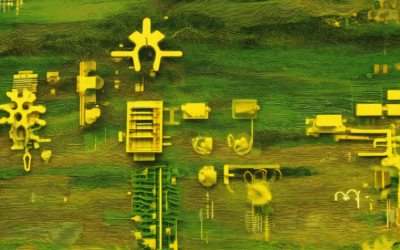In today’s fast-paced world, tech-driven growth has become the cornerstone of success for businesses across industries. As technology continues to evolve, companies are increasingly relying on innovative solutions to stay competitive and achieve sustainable growth. This comprehensive guide delves into the transformative power of technology, exploring what it means for businesses, the strategies needed to harness its potential, and the challenges that come with embracing tech-driven approaches. From understanding the fundamental concepts to examining real-world applications and future trends, this guide offers valuable insights for anyone looking to unlock the full potential of tech-driven growth.
Key Takeaways
- Understanding the Technical Progress Growth Model: Explains how technology drives economic growth and boosts productivity, offering a framework to analyze its impact.
- Breaking Down TPGM Components: Highlights key elements like the Technological Progress Function and policy implications for sustainable growth.
- Comparing Growth Models: Showcases how the TPGM uniquely focuses on specific tech-driven mechanisms unlike traditional models.
- Benefits of Using TPGM: Emphasizes its strategic value for businesses in aligning tech adoption with growth objectives.
- Software Development Impact: Discusses how software innovations enhance efficiency and decision-making in tech-driven environments.
- Hardware Innovations Role: Focuses on physical tech advancements like quantum computing and their functional boost.
- Data Processing Contributions: Explores how advanced data handling improves decision-making and operational efficiency.
- Rostow’s Growth Stages Insight: Provides a comprehensive roadmap for understanding national economic progression.

What Does It Mean to Be Tech-Driven?
To be tech-driven means that an organization relies heavily on technology to achieve its goals, operate efficiently, and innovate.
Why Are Companies Tech-Driven?
Companies become tech-driven because technology enables them to:
- Innovate faster and more effectively
- Improve operational efficiency
- Deliver better products and services to customers
- Stay competitive in a rapidly changing market
Characteristics of Tech-Driven Organizations
Tech-driven organizations typically exhibit the following traits:
- A strong focus on research and development
- Investment in advanced technologies
- Frequent adoption of new tools and systems
- A culture that embraces innovation
- Use of data analytics and AI for decision-making
The Impact of Being Tech-Driven
Being tech-driven can lead to significant benefits, including:
- Faster growth and scalability
- Improved customer experiences
- Cost savings through automation
- Competitive advantage in markets
Examples of Tech-Driven Success
Many industries have seen success stories of companies that embraced technology to achieve remarkable results. For instance:
- Automation in manufacturing has reduced production times and costs
- Data analytics has enabled personalized marketing strategies
- AI-powered tools have improved healthcare diagnostics
About Iterati
Iterati.org is a leading platform dedicated to technology, innovation, and creative problem-solving. We provide valuable resources on digital transformation, tech trends, and sustainable solutions to empower individuals and organizations to thrive in a rapidly evolving world.
Competitors in the Space
While we pride ourselves on our unique approach, there are other notable players in the field, such as:
- McKinsey & Company
- Deloitte
- PwC
- Accenture
Conclusion
Tech-driven organizations are those that leverage technology to drive progress, efficiency, and innovation. By embracing cutting-edge tools and fostering a culture of continuous learning, they unlock new possibilities and achieve extraordinary results.
What is the Meaning of Tech Growth?
Tech growth refers to the rapid expansion and evolution of technology-based sectors, characterized by continuous innovation, increased investment, and the development of new products and services that drive progress in various industries.
This growth is driven by advancements in digital services, software development, and hardware manufacturing, which collectively contribute to economic development and societal transformation. Tech growth is not only measured by the number of startups or companies entering the market but also by the technological innovations that solve real-world problems and improve efficiency across industries.
Key factors fueling tech growth include:
- The rise of digital transformation, enabling businesses to adopt new technologies and streamline operations.
- Increased access to capital and funding for tech ventures, particularly through venture capital and private equity investments.
- Government policies and regulations that support innovation and competition, such as tax incentives and research grants.
- The growing demand for tech talent, leading to the creation of specialized roles and the expansion of educational programs in STEM fields.
Tech growth has far-reaching impacts, influencing everything from consumer experiences to global trade patterns. Companies like Iterati play a pivotal role in this ecosystem by providing innovative solutions that empower businesses to thrive in a rapidly changing world. By fostering collaboration between technology and industry leaders, Iterati helps accelerate the pace of progress and ensure that tech growth continues to drive positive change.
Understanding tech growth is essential for anyone looking to participate in or benefit from the transformative power of technology. It represents not just the advancement of tools and systems but also the ongoing evolution of human potential and the future of society.

What Is a Tech-Driven Process?
A tech-driven process refers to any method or workflow that incorporates technology to enhance efficiency, productivity, or decision-making. These processes leverage technological tools, automation, and innovative solutions to achieve outcomes that might otherwise require significant manual effort or time.
Key Characteristics of Tech-Driven Processes:
- Automation : Integration of technology to handle repetitive or complex tasks, reducing human intervention.
- Data Utilization : Use of data analytics and insights to inform decisions and optimize operations.
- Innovation : Adoption of cutting-edge technologies like AI, machine learning, or IoT to drive improvements.
- Scalability : Ability to adapt and grow as technology advances, ensuring long-term effectiveness.
Examples of Tech-Driven Processes:
- Manufacturing : Use of robotics and smart machines to streamline production lines.
- Healthcare : Implementation of electronic health records (EHRs) and telemedicine platforms.
- Finance : Application of AI algorithms for fraud detection and risk assessment.
- Education : Utilization of online learning platforms and personalized learning algorithms.
Benefits of Tech-Driven Processes:
- Increased Efficiency : Reduces time spent on manual tasks, allowing teams to focus on strategic initiatives.
- Improved Decision-Making : Access to real-time data and advanced analytics fosters informed decision-making.
- Cost Savings : Streamlined operations often lead to reduced expenses and resource utilization.
- Enhanced Customer Experience : Personalized services delivered through technology improve satisfaction and engagement.
By embracing tech-driven processes, organizations can position themselves as leaders in innovation, setting the stage for sustained growth and competitiveness in their respective industries.

What is the Technical Progress Growth Model?
The Technical Progress Growth Model (TPGM) is a framework used to analyze and quantify the relationship between technological advancement and economic growth. It provides a structured approach to understanding how innovations in technology contribute to increased productivity, resource allocation, and overall societal output.
At its core, the TPGM focuses on the interaction between technological progress and factor productivity. Technological progress refers to the development and implementation of new methods, processes, or tools that enhance the efficiency of production. This progress can lead to improvements in resource utilization, labor productivity, and capital accumulation.
Key Components of the TPGM
- Technological Progress Function (TPF):
The TPF is a critical component of the TPGM that measures the impact of technological advancements on the economy. It accounts for the rate at which new technologies are adopted and their effect on output and productivity. The TPF is often modeled using input-output analysis or production functions, where technological progress enhances the efficiency of inputs like labor and capital. - Economic Growth Drivers:
The TPGM identifies the drivers of economic growth, emphasizing the role of technological innovation. By analyzing how new technologies reduce costs, increase output, and stimulate investment, the model provides insights into the mechanisms that fuel sustained growth. - Productivity Enhancements:
A central focus of the TPGM is on productivity growth. Technological progress not only increases the quantity of goods and services produced but also improves the quality and efficiency of production processes. This leads to higher returns on investment and a more competitive economy. - Policy Implications:
The TPGM can guide policymakers in designing strategies to encourage technological innovation and diffusion. By understanding the factors that promote technological progress, governments can implement policies that support R&D investment, education, and market competition.
Comparison with Competitors
While the TPGM is a unique framework, it shares similarities with other growth models, such as the Solow Growth Model and the Kaldor-Pasinetti Samuelson model. Like these models, the TPGM emphasizes the role of technological change in driving long-term economic growth. However, the TPGM differs in its focus on the specific mechanisms through which technology influences productivity and output.
Benefits of the TPGM
The TPGM offers several advantages over traditional growth models. Its emphasis on the role of technology allows for a more nuanced understanding of growth dynamics. By incorporating advanced econometric techniques, the model can provide precise predictions about the impact of technological innovations on economic outcomes.
For businesses, the TPGM serves as a valuable tool for strategic planning. Companies can use the model to assess the potential benefits of adopting new technologies and to allocate resources effectively. This alignment with business objectives ensures that the TPGM remains a practical and actionable framework.
Conclusion
The Technical Progress Growth Model is a powerful analytical tool that bridges the gap between technological innovation and economic growth. By quantifying the impact of technology on productivity and output, the TPGM provides a robust foundation for understanding and managing growth in a rapidly evolving world.
What Are the Three Types of Technical Progress?
The progression of technology can be categorized into three distinct types, each driving innovation and advancement in different domains. Here’s a breakdown:
- Software Development
- This involves the creation and improvement of programs, applications, and systems.
- Examples include advancements in artificial intelligence, machine learning, and cloud computing.
- These innovations enhance efficiency, productivity, and decision-making capabilities.
- Hardware Innovations
- This type focuses on physical devices and machinery.
- Examples include developments in quantum computing, autonomous vehicles, and robotics.
- Hardware advancements enable faster processing, greater connectivity, and improved functionality.
- Data Processing Advancements
- This category deals with the collection, analysis, and utilization of information.
- Examples include big data analytics, natural language processing, and Internet of Things (IoT) technologies.
- Better data handling enhances decision-making, personalization, and operational efficiency.
Each of these types of technical progress contributes uniquely to shaping the modern world, pushing boundaries, and solving complex problems.

The 5-Stage Growth Model
Rostow’s Stages of Economic Growth and Development outlines a comprehensive framework to understand the progression of economies from underdeveloped to developed nations. Below is a breakdown of the five primary stages:
- Traditional Society : In this initial stage, economies rely heavily on agriculture and manual labor. Societies are characterized by subsistence living and minimal industrial activities.
- Preconditions for Takeoff : As societies evolve, they develop basic infrastructure, education, and institutional frameworks necessary to support sustained economic growth. This stage often involves technological innovations and social changes.
- Takeoff : This phase marks the beginning of rapid industrialization and urbanization. Economies transition from agrarian to industrialized, leading to significant increases in productivity and wealth.
- Drive to Maturity : During this stage, economies continue to industrialize and diversify their production bases. They focus on expanding manufacturing capabilities and developing advanced technologies.
- Age of High Mass Consumption : In this final stage, economies are well-established and highly developed. They prioritize consumer goods, services, and technological innovation, leading to a high standard of living for their populations.
This model highlights the sequential nature of economic development and provides a roadmap for understanding how nations progress toward becoming developed economies. Policymakers, businesses, and researchers often use Rostow’s framework to guide strategic planning and decision-making.




0 Comments